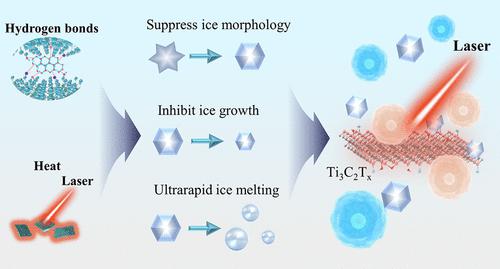Our official English website, www.x-mol.net, welcomes your
feedback! (Note: you will need to create a separate account there.)
Inhibition Effect of Ti3C2Tx MXene on Ice Crystals Combined with Laser-Mediated Heating Facilitates High-Performance Cryopreservation
ACS Nano ( IF 15.8 ) Pub Date : 2022-06-13 , DOI: 10.1021/acsnano.1c10221 Yuan Cao 1 , Tie Chang 2 , Chao Fang 1 , Yuanyuan Zhang 1 , Huilan Liu 1 , Gang Zhao 1, 2
ACS Nano ( IF 15.8 ) Pub Date : 2022-06-13 , DOI: 10.1021/acsnano.1c10221 Yuan Cao 1 , Tie Chang 2 , Chao Fang 1 , Yuanyuan Zhang 1 , Huilan Liu 1 , Gang Zhao 1, 2
Affiliation

|
The phenomena of ice formation and growth are of great importance for climate science, regenerative medicine, cryobiology, and food science. Hence, how to control ice formation and growth remains a challenge in these fields and attracts great interest from widespread researchers. Herein, the ice regulation ability of the two-dimensional MXene Ti3C2Tx in both the cooling and thawing processes is explored. Molecularly speaking, the ice growth inhibition mechanism of Ti3C2Tx MXene is ascribed to the formation of hydrogen bonds between functional groups of −O–, −OH, and −F distributed on the surface of Ti3C2Tx and ice/water molecules, which was elucidated by the molecular dynamics simulation method. In the cooling process, Ti3C2Tx can decrease the supercooling degree and inhibit the sharp edge morphology of ice crystals. Moreover, taking advantage of the outstanding photothermal conversion property of Ti3C2Tx, rapid ice melting can be achieved, thus reducing the phenomena of devitrification and ice recrystallization. Based on the ice restriction performance of Ti3C2Tx mentioned above, Ti3C2Tx is applied for cryopreservation of stem-cell-laden hydrogel constructs. The results show that Ti3C2Tx can reduce cryodamage to stem cells induced by ice injury in both the cooling and thawing processes and finally increase the cell viability from 38.4% to 80.9%. In addition, Ti3C2Tx also shows synergetic antibacterial activity under laser irradiation, thus realizing sterile cryopreservation of stem cells. Overall, this work explores the ice inhibition performance of Ti3C2Tx, elucidates the physical mechanism, and further achieves application of Ti3C2Tx in the field of cell cryopreservation.
中文翻译:

Ti3C2TX MXene 对冰晶的抑制作用与激光介导的加热相结合有助于实现高性能低温保存
冰的形成和生长现象对于气候科学、再生医学、低温生物学和食品科学具有重要意义。因此,如何控制冰的形成和生长仍然是这些领域的挑战,并引起了广大研究人员的极大兴趣。在此,探索了二维 MXene Ti 3 C 2 T x在冷却和解冻过程中的冰调节能力。从分子上讲,Ti 3 C 2 T x MXene 的冰生长抑制机制归因于分布在 Ti 3 C 2 T x表面的-O-、-OH 和-F 官能团之间形成氢键。和冰/水分子,这是通过分子动力学模拟方法阐明的。在冷却过程中,Ti 3 C 2 T x可以降低过冷度,抑制冰晶的锐边形貌。此外,利用Ti 3 C 2 T x出色的光热转换特性,可以实现冰的快速融化,从而减少失透和冰重结晶现象。基于上述Ti 3 C 2 T x的冰限制性能,Ti 3 C 2 T x用于冷冻保存载有干细胞的水凝胶结构。结果表明,Ti 3 C 2 T x可以降低干细胞在冷却和解冻过程中因冰损伤引起的冷冻损伤,最终使细胞活力从38.4%提高到80.9%。此外,Ti 3 C 2 T x在激光照射下也表现出协同抗菌活性,从而实现了干细胞的无菌超低温保存。总体而言,本工作探索了Ti 3 C 2 T x的抗冰性能,阐明了物理机制,进一步实现了Ti 3 C 2 T的应用。x在细胞冷冻保存领域。
更新日期:2022-06-13
中文翻译:

Ti3C2TX MXene 对冰晶的抑制作用与激光介导的加热相结合有助于实现高性能低温保存
冰的形成和生长现象对于气候科学、再生医学、低温生物学和食品科学具有重要意义。因此,如何控制冰的形成和生长仍然是这些领域的挑战,并引起了广大研究人员的极大兴趣。在此,探索了二维 MXene Ti 3 C 2 T x在冷却和解冻过程中的冰调节能力。从分子上讲,Ti 3 C 2 T x MXene 的冰生长抑制机制归因于分布在 Ti 3 C 2 T x表面的-O-、-OH 和-F 官能团之间形成氢键。和冰/水分子,这是通过分子动力学模拟方法阐明的。在冷却过程中,Ti 3 C 2 T x可以降低过冷度,抑制冰晶的锐边形貌。此外,利用Ti 3 C 2 T x出色的光热转换特性,可以实现冰的快速融化,从而减少失透和冰重结晶现象。基于上述Ti 3 C 2 T x的冰限制性能,Ti 3 C 2 T x用于冷冻保存载有干细胞的水凝胶结构。结果表明,Ti 3 C 2 T x可以降低干细胞在冷却和解冻过程中因冰损伤引起的冷冻损伤,最终使细胞活力从38.4%提高到80.9%。此外,Ti 3 C 2 T x在激光照射下也表现出协同抗菌活性,从而实现了干细胞的无菌超低温保存。总体而言,本工作探索了Ti 3 C 2 T x的抗冰性能,阐明了物理机制,进一步实现了Ti 3 C 2 T的应用。x在细胞冷冻保存领域。











































 京公网安备 11010802027423号
京公网安备 11010802027423号